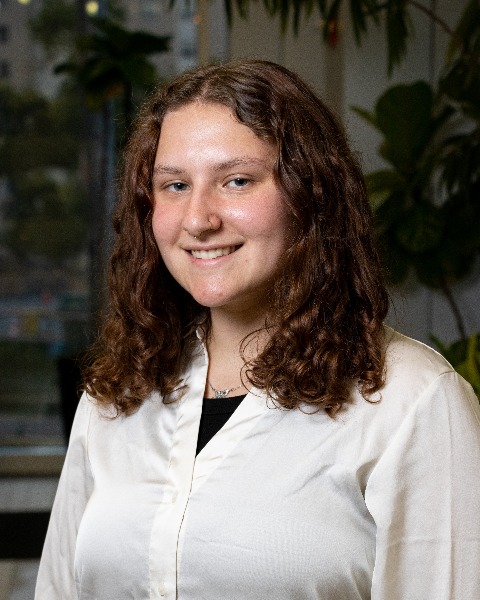Cellular and Molecular Bioengineering
(H-311) Assessing the Growth Dynamics of a Mock Community with Pseudomonas aeruginosa and Staphylococcus aureus

Elizabeth Medvedeva (she/her/hers)
Bioengineering Undergraduate Student
University Of Pittsburgh
Pittsburgh, Pennsylvania, United States- TN
Tagbo Niepa
Assistant Professor
University of Pittsburgh, United States - HU
Huda Usman
PhD Student
University of Pittsburgh, United States
Presenting Author(s)
Primary Investigator(s)
Last Author(s)
Pseudomonas aeruginosa and Staphylococcus aureus are pathogens that often form the microbial communities found within cystic fibrosis patients and wound infections. The interactions between these two pathogens are complex and make co-infections difficult to treat due to heightened antibiotic resistance and increased virulence [1]. Understanding these interactions is of utmost importance for developing better treatments for infections involving both P. aeruginosa and S. aureus. Numerous studies have been done to establish what factors shape interactions between these two pathogens and how they affect their host, however much remains unknown [2]. In this work, encapsulation of P. aeruginosa and S. aureus in semi-permeable polymeric microcapsules allows for further observation of and experimentation with their versatile interactions.
Materials and Methods::
A microfluidic device is used to produce microcapsules made of polydimethylsiloxane (PDMS) containing bacteria in culture medium. The microfluidic device is made of two glass capillaries facing each other, with diameters of 40 uM and 180 uM, respectively. Three fluids: bacteria in culture medium, 5% polyvinyl alcohol (PVA), and PDMS are delivered to the device through syringes attached to polyethylene tubing [3]. Pumps are used for each syringe containing fluid to control their flow rate through the device. Progress of the encapsulation is monitored under a microscope. Microcapsules are made as PDMS and PVA form an interface, allowing PDMS to enclose around the bacteria and culture medium. Droplets containing microcapsules are collected and stored in a 37 C incubator until they are ready to be imaged.
In order to study interactions between S. aureus and P. aeruginosa, the bacteria are combined in volumetric ratios, 10:1, 5:1, and 1:1, within microcapsules to observe how the growth dynamics change as S. aureus is increased relative to P. aeruginosa. In further experiments, microcapsules containing S. aureus are collected in media containing microcapsules with P. aeruginosa and also in media containing supernatant from an overnight P. aeruginosa culture.
Microcapsules are imaged using fluorescence and confocal microscopy. Strains of P. aeruginosa and S. aureus used are tagged with fluorescent protein. Fluorescence intensity calculated in ImageJ is used to quantitatively assess growth dynamics of the two strains.
Results, Conclusions, and Discussions::
In experiments where P. aeruginosa and S. aureus are co-cultured in the microcapsule, the results showed that relative fluorescence intensity of S. aureus to P. aeruginosa increased with increasing density of S. aureus. P. aeruginosa continued to be the dominant strain, indicated by a consistently higher relative fluorescence intensity to the S. aureus across all volumetric ratios tested.
In experiments where P. aeruginosa and S. aureus are each separately in their own microcapsules but combined within the same collection medium, there is a decrease in the presence of S. aureus between the control and the combined sample. The decrease is not as significant as it is when P. aeruginosa and S. aureus are within the same microcapsule.
In experiments where S. aureus is collected in the supernatant produced by P. aeruginosa, the growth of S. aureus is significantly inhibited. There is an increase in Corrected Total Cell Fluorescence (CTCF/nL) in samples of S. aureus microcapsules collected in medium containing a lower percentage of P. aeruginosa supernatant. This shows the presence of metabolites produced by P. aeruginosa is sufficient to inhibit the growth of S. aureus within the microcapsules, without the presence of P. aeruginosa itself.
When P. aeruginosa and S. aureus are within the same capsule, both physical and chemical interactions occur, causing growth inhibition of S. aureus. Increasing the inoculation density of S. aureus results in less inhibition. When S. aureus and P. aeruginosa are in separate microcapsules, chemical interactions between the two bacteria occur when metabolites produced by P. aeruginosa diffuse into the microcapsule and inhibit S. aureus growth. Increasing the presence of P. aeruginosa metabolites increases this inhibition, as shown in experiments where S. aureus microcapsules are incubated in P. aeruginosa supernatant. Using microcapsules as the method of studying these interactions allows for a controlled way of introducing different conditions and analyzing bacteria growth to identify and confirm physical and chemical interactions between P. aeruginosa and S. aureus.
Acknowledgements (Optional): : The microBiointerface Lab
University of Pittsburgh Summer Undergraduate Research Internship
University of Pittsburgh School of Pharmacy
References (Optional): :
[1] Nguyen, A. T., & Oglesby-Sherrouse, A. G. (2016). Interactions between Pseudomonas aeruginosa and Staphylococcus aureus during co-cultivations and polymicrobial infections. Applied Microbiology and Biotechnology, 100(14), 6141–6148. https://doi.org/10.1007/s00253-016-7596-3
[2] Yung, D. B. Y., Sircombe, K. J., & Pletzer, D. (2021). Friends or enemies? The complicated relationship between Pseudomonas aeruginosa and Staphylococcus aureus. Molecular Microbiology, mmi.14699. https://doi.org/10.1111/mmi.14699
[3] Niepa, T. H. R., Hou, L., Jiang, H., Goulian, M., Koo, H., Stebe, K. J., & Lee, D. (2016). Microbial nanoculture as an artificial microniche. Scientific Reports, 6(1), 30578. https://doi.org/10.1038/srep30578
